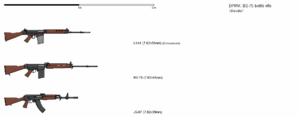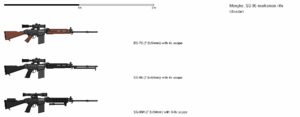BS-75
| Type 75 Semi-Automatic Rifle (BS-75) | |
|---|---|
 The BS-75, center, alongside the L1A1 and JS-67. | |
| Type | Battle rifle |
| Place of origin | |
| Service history | |
| In service | 1975-present |
| Used by | |
| Production history | |
| Designer | Hwasŏng Arsenal 55 |
| Designed | 1971-1975 |
| Manufacturer | 2nd Machine Plant, Taekchŏn |
| Produced | 1975-1998 |
| Variants | see below |
| Specifications (BS-75) | |
| Weight | 4.5 kg |
| Length | 1240 mm |
| Barrel length | 604 mm |
| Cartridge | 7.5×54mm |
| Action | Gas operated, tilting bolt |
| Rate of fire | semi-automatic |
| Muzzle velocity | 850 m/s |
| Effective firing range | 800 m (with scope) |
| Feed system | 20-round detachable box magazine |
| Sights | Adjustable iron sights PSO-1 4x scope |
The BS-75 (Formal designation: 75식 반자동 소총 / 七五式半自動小銃, chil-o-sik ban-jadong sochong, "Type 75 semi-automatic rifle;" short designation 75식 chiro-sik "Type 75") is a semi-automatic firearm developed in the Democratic People's Republic of Menghe. It was developed from the L1A1 self-loading rifle, which Menghean guerillas had captured from Tyrannian and Republic of Menghe forces during the Menghean War of Liberation. While in active service, the BS-75 was used as either a battle rifle or designated marksman rifle. A shortened variant with a fully automatic fire setting was produced as the JS-78.
Development
At the end of the Menghean War of Liberation, the Menghean People's Army inherited large numbers of L1A1 self-loading rifles and 7.5×54mm AVA cartridges, some captured from Tyrannian battle dead and others from Republic of Menghe Army arsenals which the insurgents had overrun. While the MPA decided to adopt a 7.62×39mm AN-based firearm, the JS-67, as its main infantry weapon, its soldiers soon became fond of the L1A1, which had greater accuracy at range and was still acceptably reliable. Denied rights to import the latest sniper rifles from Letnia, the MPA continued to issue captured L1A1s to designated marksmen, and set up a plant to manufacture 7.62×51mm ammunition without license.
Concerned about the sustainability of using captured weapons only, in 1970 the Menghean People's Army issued a design requirement for a new rifle that would replace the L1A1. Hwasŏng Arsenal 55, the designers of the JS-67, responded by beginning work on an improved L1A1 derivative. The weapon was accepted for service in 1975, earning its official designation as the "Type 75 Semi-Automatic Rifle" or BS-75.
Design
Internally, the BS-75 is very similar to the L1A1, with a tilting bolt action of nearly the same dimensions. Individual parts are not fully interchangeable, however, as the BS-75 reverted to metric measurements (while still remaining distinct from the original FN FAL). Like the L1A1, it lacks a fully automatic rate-of-fire setting, as it was designed for use by sharpshooters rather than front-line infantry. It also has a longer barrel, intended to improve accuracy at range, and a rail on the left side of the receiver which can be used to mount magnifying optics.
During the design process, the Hwasŏng Arsenal initially considered switching to stamped parts, but ultimately determined that it was not feasible to stamp metal at an adequate thickness to withstand the force of the tilting bolt mechanism. Thus, as on the L1A1, the entire receiver assembly is milled. For field stripping and cleaning, the receiver opens along a pivot point between the magazine well and the trigger.
The BS-75 also uses 7.62×54mm ammunition, in contrast to most Letnian rifles and machine-guns, which adopted 7.62×54mm rimmed cartridges. The individual magazines and magazine release mechanism, however, are domestically designed to a metric-based pattern, and are incompatible with Tyrannian or Sieuxerrian magazines.
Further contrasts with the L1A1 are listed below:
- The buttstock has a distinct "neck" just behind the receiver, closely resembling that on the JS-67.
- The handguard is somewhat longer overall, and tapers slightly from the receiver toward the muzzle. It is also divided into an upper and lower half, with only two openings in between, as on the JS-67 and most AN-series rifles.
- There is no carrying handle, a distinct feature on the L1A1 and FN FAL.
- The iron sights are similar to those used on the AN series, with a tangent-style adjustable rear sight.
- The trigger assembly is slightly different, again reflecting AN series influence.
- The ejection port is more "squared" along the top and bottom.
JS-78
The JS-78, or Type 78 Short Rifle (78식 자동 소총, Chil-pal-sik jadong sochong), was a major variant of the BS-75 which entered service in 1978. Though officially designated a carbine, at 1.096 meters from buttstock to muzzle it was actually longer than the later-series L1A1 with composite furniture and modified muzzle, and longer than the JS-67 with rifle-grenade spigot. The JS-78 has both semi-automatic and fully automatic rate-of-fire options, making it closer to a true battle rifle, and is capable of mounting a bayonet.
The JS-78 is capable of firing the same variety of rifle grenades as the JS-67, namely the Type 68 HEAT, Type 70GP high-explosive, and Type 70YM smokescreen rounds. It is considered unsafe to fire the Type 80 and later models, however, as the grenade's bullet trap was optimized for 7.62x39mm ammunition coming out of a shorter barrel. As on the JS-67, the operator mounts a special rifle-grenade sight on the left side of the receiver, slides the grenade over the extended muzzle spigot, adjusts the gas valve, loads a special blank round a separate pack, and fires from the shoulder (at setting 1, when the grenade's tail is only 1/3 of the way down the spigot) or with the buttstock braced against the ground (at settings 2 and 3).
Because early trials found that the BS-75's barrel could bend or warp from the pressure and recoil of launching rifle grenades, the JS-78 switched to a thicker barrel and a sturdier handguard, and consequently it is somewhat heavier than the BS-75 despite being shorter. Apparently these measures never fully resolved the warping issue, as during the mid-1980s JS-78s issued to grenadiers were modified with tightly wrapped metal wire to prevent the wooden handguard from fracturing. Similar improvised solutions can be found on JS-78s which found their way into the hands of non-state militaries.
SS-95
The SS-95 (Long designation: 95식 사수 소총 / 九五式射手小銃, gu-o-sik sasu sochong, "Type 95 marksman rifle") is an accurized version of the BS-95 intended for use by designated marksmen in rifle platoons. Changes include a more vertical pistol grip and lighter polymer furniture. These weapons are also machined to more rigorous tolerance levels. A bipod can be mounted to the barrel just forward of the handguard. As on the BS-75 and BS-78, optics are mounted using a dovetail rail on the top of the receiver.
In 2012, Hwasŏng Arsenal 55 introduced the SS-95H. This incorporates a built-in Hwasŏng rail on the top of the receiver, allowing for greater customization in the mounting of optics and better stability of the optics mount against recoil. The foregrip also uses a cut-out Hwasŏng frame to allow the mounting of foregrips, flashlights, laser sights, and other modifications. Hwasŏng also added an adjustable cheek rest on the buttstock, a change which could be retrofitted to existing SS-95s.
By this time, however, the Menghean Army had already adopted the more compact SS-110 marksman rifle, which received a similar modification shortly after its introduction. The SS-95H is still offered for export, along with its cousin the SS-95P, which uses a Picatinny rail for greater compatibility with foreign optics.
Other variants
- BS-75L: Unsuccessful export variant rechambered in 7.62×54mmR for sale to the Letnia and its allies.
- SS-95T: Trials variant of the SS-95 chambered in Glasic 7mm Quinn. Found to have better performance at long range, but rejected due to lack of ammunition commonality.
Service
From 1975 until the mid-1990s, the BS-75 was the most advanced designated marksman rifle in the Menghean armed forces, with one marksman per platoon. It has since been replaced in active service, but remains common in reservist units.
During the late 1970s and early 1980s, the DPRM supplied large numbers of BS-75 and JjS-78 rifles to armed insurgent movements in Hemithea and Meridia, and many remain in circulation today.
Dzhungestan remains a major user of the BS-75 and JS-78, issuing them to border patrol units and armed police. As of 2014, all Dzhungestani Army motorized units have switched to the JS-103, but reservist and light infantry units continue to use the older battle rifles.
Users


